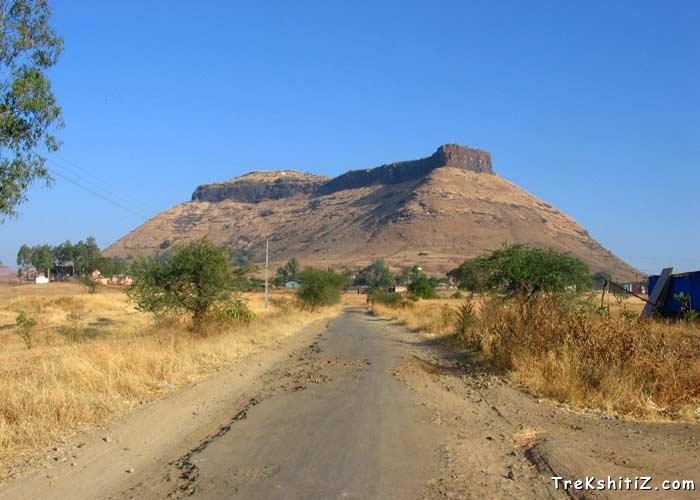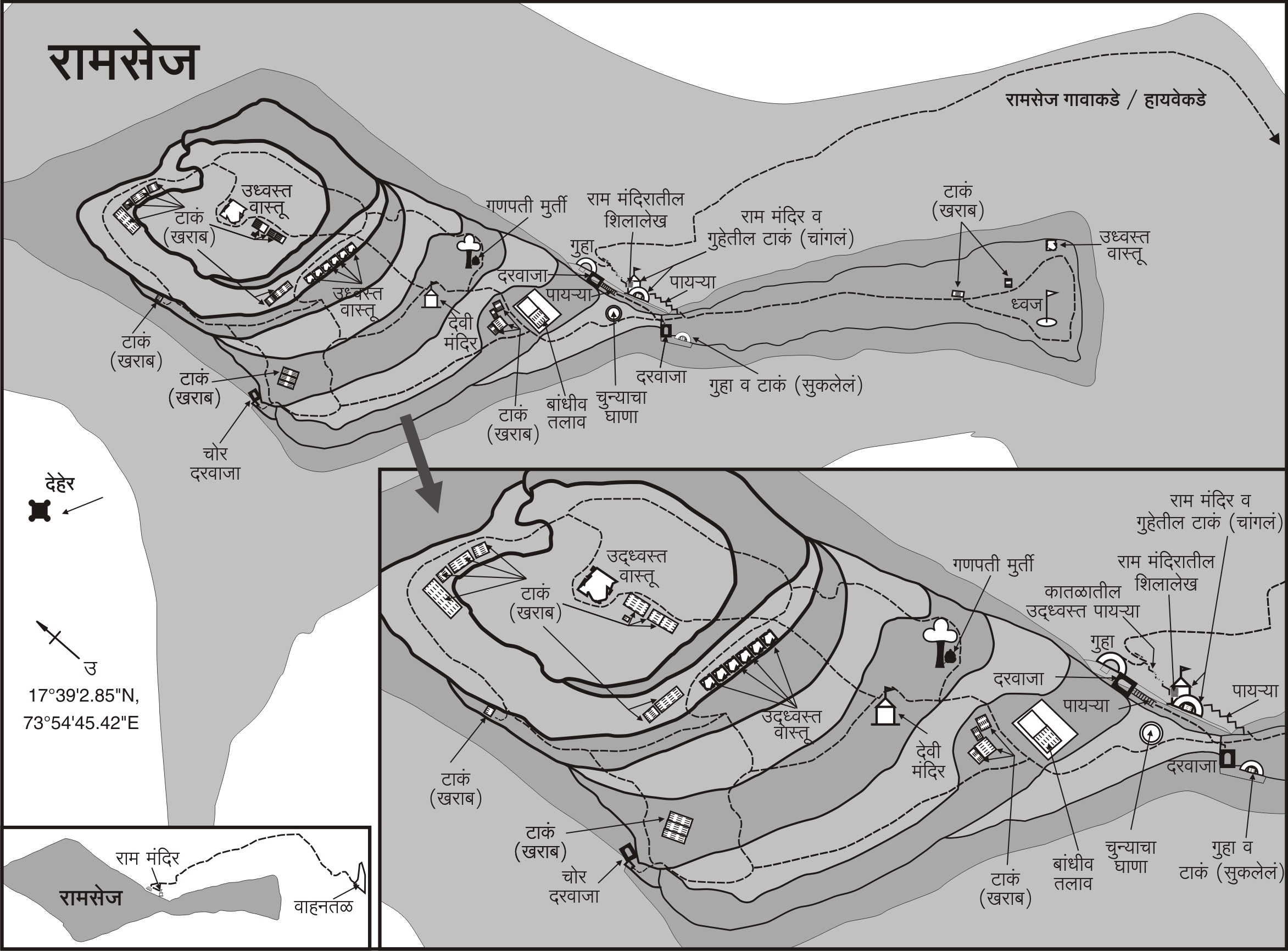| Fort Name : | Alphabetically | RangeWise | DistrictWise | CategoryWise | GradeWise |
| Ramshej | FortHeight : 3200 ft. from MSL | ||||
| Type : Hill forts | Fort Range : Peth, Nashik | ||||
| District : Nashik | Grade : Medium | ||||
| Ramshej Fort is located north of Nashik city, and has been historically significant. History has it, that the fort was attacked by Mughals (Aurangzeb’s army), and his commanders threatened the Maratha kingdom saying that they would capture the fort in hours. Shivaji Maharaj’s son Sambhaji and his army resisted these attacks for almost 6 years. One can find the references to this battle well fought by brave Maratha warriors from Mughal letters. | |||||
|
|||||
| History : | |||||
| Ramshej literally means Lord Ram’s bedstead. While in exile, Lord Ram had made this place as his residence for some time, which gives the fort its name. During reign of Sambhaji, Aurangzeb came to Maharashtra with the motive to destroy Hindavi Swarajya completely. Nashik was under the command of Mughals. Since Ramshej is near Nashik, the Mughals thought it would be the easiest to conquer it but proved to be a hard nut to crack. To conquer this fort Aurangzeb sent Shahbuddin Gaziudin Firozejung with an army of 40,000 soldiers and canons. The Mughals sieged the fort when the fort had only 600 Mavalas. The first attack came from the Mughals to which the Mavalas replied by a massive stone attack. As a result of this attack, the Mughals had to back off. Afterwards Shahbuddin tightened the siege, dynamited the area and installed wooden platforms to hold the canons and many more ideas followed. The Killedar (commander) of Ramshej fort was an experienced and intelligent strategist and put an end to their daydreams. Shahbuddin’s obstinate desire to win made him think carefully. “He made a wooden bastion capable enough to accommodate 500 men and 50 canons. Accordingly the surrounding forest was cleared to construct a huge wooden bastion. The Mughals attempted attacks from the bastion, which failed eventually. In May 1662, Sambhaji Maharaj sent Rupaji Bhosale and Manaji More with an army of 7000 to break the siege. Shahbuddin checked the advance of Marathas at a place near Ganeshgaon. Both the armies fought fiercely in which the Mughals lost their 500 horses to the Marathas. This victory filled the Marathas with enthusiasm. But due to this retreat, Aurangzeb got agitated and commanded Bahadur Khan to march towards Ramshej. Shahbuddin tightened the siege and resumed the attack on the fort, to which Mavalas replied with massive stone attack. Raja DalapatRai got injured in this attack due to which Mughals had to retreat. Due to consistent failures Shahbuddin left for Junnar calling off the siege. Bahadur Khan took the responsibility of this siege. He devised a new strategy to attack the fort, wherein a part of the Mughal army consisting canons and instruments stationed at one side of the fort to keep the Marathas engaged and the remaining force would attack from the other side. However Marathas somehow became aware of this strategy and divided their army to stations on both sides of the fort, which foiled the plans of the Mughals. Bahadur Khan called in a Tantrik to devise a new strategy. The Tantrik asked for a golden serpent (snake statue) weighing 100 tola. He claimed to use the serpent and lead the Mughal army to the main gate of the fort. Khan followed his instructions and Tantrik led the army by keeping eye on the fort. When they reached within the range of attack, Marathas started their stone attacks. The Tantrik got hit by a rock and the serpent felt on the ground from his hands. The Mughals were aghast and had to retreat. Aurangzeb got agitated and ordered Bahadur Khan to retreat. After this Aurangzeb sent Kasimkhan Kiramani to march towards Ramshej, but he too failed to get the fort. Hence, the ferocious Marathas fought bravely for about 65 months and proved how strong their forts are. |
|||||
| Fascinating Spots : | |||||
| Ram Mandir : | |
| The way to the fort starts from its base village on the south side, and goes to the top from the east face. En route, there is a small temple of lord Ram inside a huge cave. The cave is well maintained by the devotees and offers a nice place to stay. Inscription near the cave can be clearly seen. One cistern lies on southwards of this cave, which has potable water. Broken steps in front of this cave take us to top of the fort. There exists a secret tunnel which is now inaccessible. The trail from here leads to one side of the fort, and the leftward route from the bifurcation leads to a narrow shaped Machi. The route that goes from right side ends up in a cliff. | |
| Mukhya Darwaja (Main Entrance) : | |
| The ‘Main Gate’ is constructed beneath the cliff, which is quite huge, but devastated now. Returning to the main route and after climbing some distance, one can reach to the plateau where we find two cisterns and one big pond. | |
| Devi Mandir : | |
| By climbing some more distance, we come across a Devi Mandir which holds the celebration of Navratri Festivals. By going bit down from back of this Mandir, there is another Gupt Darwaja (secret doorway) of this fort. And the route in front of this Mandir takes us to another side of the fort where two more cisterns exist. While back to this route, one can found destroyed parts/remains of homes. Returning to the Mukhya Darwaja, leftward route goes to the plateau, where exists two-three cisterns and at the end of this plateau, there is a flag post. It takes around two hours to see the fort completely. Dehergad (Bhorgad) and Chambhar Caves can also be seen from the fort. | |
| Ways To Reach : | |
| First we have to reach Nashik. Then board a S.T from Nashik's CBS bus station to Peth and alight at the Aashewadi Phata. A walk of some minutes takes us to Aashewadi village, from where we can see the fort. Route to fort goes from the back side of the village by keeping fort at the left side. It takes 1 hour to climb the fort from this route. | |
| Accommodation Facility : | |
| The temple is good place to stay and can accommodate around 10 people at a time. | |
| Food Facility : | |
| Food arrangements have to be made by our own. | |
| Drinking Water Facility : | |
| There are cisterns which are a source of drinking water all year round. | |
| Time To Reach : | |
| 1 hour from Aashewadi village | |
| Best Season To Visit : | |
| All the year |
| Marathi Version |

